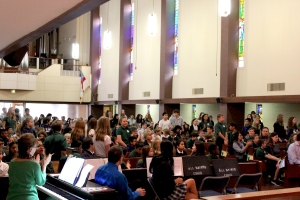
Leo P. Dressel, Head of School, All Saints’ Episcopal Day School
Making Private School Education More Accessible
The landscape within private school education has changed dramatically and rapidly. Two contextual factors have played a major role in some of the most recent changes in that landscape. The lengthy recession has had long-term financial impact on schools, requiring the need to devote more tuition assistance to more families — including some who could previously pay the full tuition at a school. The “new normal” makes determination of annual tuition levels a more painstaking process, which in fact requires careful stewardship.
A second factor that has had significant influence is the growth of charter schools, a particularly impactful reality in Arizona. As school options have increased, private schools now have to demonstrate and communicate more effectively their educational and developmental value – and not just their cost.
There always will be a role for private education in our country, but in order for those schools to thrive they will have to be flexible, nimble and creative. I strongly believe that the best private schools have a clear community purpose and that purpose can be embodied in a variety of ways.
One way a private school can achieve its public purpose is by a commitment to easier access of education to traditionally underserved segments of our community, especially during the crucial early learning years. This commitment of inclusion is deeply rooted in the All Saints’ Episcopal Day School educational philosophy and school culture.
We recognize paying for an independent school education can be a challenge for many families, and it is our goal that economic standing should not be the only determining factor when weighing educational options. Therefore, we have adopted the Indexed Tuition model because we want to provide our offerings to as many deserving children as possible by working with each individual family’s situation.
Diversity on every level enriches the educational opportunity for all students, and participation of a wide range of families is critical to a healthy thriving school and overall student experience. Indexed Tuition allows us to further enrich the community, fosters inclusion, and enhances the educational and social-emotional experience for both children and their parents.
At a school like ours, which is pre-secondary in scope, we are acutely aware our mission is to prepare our graduates for extensive continued high-quality education and personal development long after they leave us. Our mission statement captures that sentiment quite well in its closing words: “preparing students to lead fruitful lives and to serve a world in need.” At the core of our mission is a commitment to enable all students to lead lives not only of success but more importantly of meaning and purpose.
Globalization is a reality that cannot be ignored by schools. While there remains essential value in a school being a safe haven, no longer can we be places of insularity and exclusivity. We must prepare our students for the world in which they will live their adult lives, and so we must open the world to them in developmentally appropriate ways while they are with us.
We have the luxury of offering a rich palette of enrichment experiences for our students on an intimate scale that ensures that no student falls through the cracks. We can set our expectations high without apology and with the support of the school community. One way in which we describe this dimension of our school is as a place of “maximum challenge and maximum support.”
The Episcopal identity of our school is also a wonderful asset since we have a clear religious identity, one core feature of which is a commitment to inclusion. We encourage every child and adult to respect his or her own religious and cultural traditions, and also the traditions of others. We are able to speak and act clearly regarding the non-cognitive dimensions of a quality education of children “in the light of God-mind, body, soul.”
While my life’s work has been in the sector of independent private education, most of it in faith-based schools, I am a strong supporter of public education. As states have felt the negative effects of the recession and its lingering aftermath, support for public education seems to have taken a disproportionate share of the brunt of budgetary constriction. This is certainly true in Arizona.
Accountability is important and necessary for all schools, but the budgetary approach taken in many states seems quite shortsighted. Both the educational and business communities seem to recognize this, but the political sector seems to be on a different page. I happen to believe that a community is strongest when the traditional public school, charter public school, and private school sectors are all healthy. That is not the case in most parts of the country, and we are the poorer for it- now and in the years to come.
Leo P. Dressel is head of school at All Saints’ Episcopal Day School.
For more information about the Indexed Tuition program offered at All Saints’, please call 602.274.4866 or visit http://www.aseds.org/.

 Much has changed for the Boss on that score, and much has changed for me on many levels over these 40 years. In 1975 I was a second-year student at Jesuit School of Theology in Berkeley preparing for ordination to the priesthood. For the 2016 concert our delegation represented three generations, which I found most consoling. Our granddaughters have little knowledge of Springsteen’s career so I was excited to experience their introduction to his music with them. I was also proud since—as a self-described Springsteen disciple—I take a bit of credit for encouraging and supporting their father’s allegiance to the Boss.
Much has changed for the Boss on that score, and much has changed for me on many levels over these 40 years. In 1975 I was a second-year student at Jesuit School of Theology in Berkeley preparing for ordination to the priesthood. For the 2016 concert our delegation represented three generations, which I found most consoling. Our granddaughters have little knowledge of Springsteen’s career so I was excited to experience their introduction to his music with them. I was also proud since—as a self-described Springsteen disciple—I take a bit of credit for encouraging and supporting their father’s allegiance to the Boss. This development can be good news for children and adults, but there is an ever growing number of cautionary tales. Not a week goes by that I do not see an article in professional literature about the perils of excessive screen time for young people. This is of particular concern for me as head of a school with a 1-to-1 iPad program in our middle school and a commitment to the incorporation of other new technologies into our PK-8 educational program. One of the harmful side effects of excessive screen time is the deleterious effect if has on the development of social-emotional skills in students (and all of us, for that matter). This has risen to the level of a public health issue as demonstrated by the guidelines developed by the
This development can be good news for children and adults, but there is an ever growing number of cautionary tales. Not a week goes by that I do not see an article in professional literature about the perils of excessive screen time for young people. This is of particular concern for me as head of a school with a 1-to-1 iPad program in our middle school and a commitment to the incorporation of other new technologies into our PK-8 educational program. One of the harmful side effects of excessive screen time is the deleterious effect if has on the development of social-emotional skills in students (and all of us, for that matter). This has risen to the level of a public health issue as demonstrated by the guidelines developed by the 



